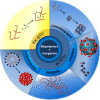Biopolymer colloids for controlling and templating inorganic synthesis
- PMID: 25551041
- PMCID: PMC4273287
- DOI: 10.3762/bjnano.5.222
Biopolymer colloids for controlling and templating inorganic synthesis
Abstract
Biopolymers and biopolymer colloids can act as controlling agents and templates not only in many processes in nature, but also in a wide range of synthetic approaches. Inorganic materials can be either synthesized ex situ and later incorporated into a biopolymer structuring matrix or grown in situ in the presence of biopolymers. In this review, we focus mainly on the latter case and distinguish between the following possibilities: (i) biopolymers as controlling agents of nucleation and growth of inorganic materials; (ii) biopolymers as supports, either as molecular supports or as carrier particles acting as cores of core-shell structures; and (iii) so-called "soft templates", which include on one hand stabilized droplets, micelles, and vesicles, and on the other hand continuous scaffolds generated by gelling biopolymers.
Keywords: biomacromolecules; biopolymer; colloid; nanoparticle; organic–inorganic hybrid; template.
Figures








Similar articles
-
Soft vesicles in the synthesis of hard materials.Acc Chem Res. 2012 Apr 17;45(4):504-13. doi: 10.1021/ar200124g. Epub 2012 Jan 18. Acc Chem Res. 2012. PMID: 22257298
-
In Situ Synthesis of Metal Nanoparticle Embedded Hybrid Soft Nanomaterials.Acc Chem Res. 2016 Sep 20;49(9):1671-80. doi: 10.1021/acs.accounts.6b00201. Epub 2016 Aug 23. Acc Chem Res. 2016. PMID: 27552443
-
Selection of biomolecules capable of mediating the formation of nanocrystals.ACS Nano. 2007 Oct;1(3):154-9. doi: 10.1021/nn7002019. ACS Nano. 2007. PMID: 19206645
-
Continuous flow structuring of anisotropic biopolymer particles.Adv Colloid Interface Sci. 2009 Aug 30;150(1):16-26. doi: 10.1016/j.cis.2009.05.005. Epub 2009 May 18. Adv Colloid Interface Sci. 2009. PMID: 19481192 Review.
-
Biopolymers Hybrid Particles Used in Dentistry.Gels. 2021 Mar 22;7(1):31. doi: 10.3390/gels7010031. Gels. 2021. PMID: 33809903 Free PMC article. Review.
Cited by
-
Low-Temperature Miniemulsion-Based Routes for Synthesis of Metal Oxides.Chemistry. 2020 Jul 27;26(42):9304-9313. doi: 10.1002/chem.202001246. Epub 2020 Jul 9. Chemistry. 2020. PMID: 32441349 Free PMC article. Review.
-
Chemical bath deposition of textured and compact zinc oxide thin films on vinyl-terminated polystyrene brushes.Beilstein J Nanotechnol. 2016 Jan 25;7:102-10. doi: 10.3762/bjnano.7.12. eCollection 2016. Beilstein J Nanotechnol. 2016. PMID: 26925358 Free PMC article.
-
Two-dimensional collagen-graphene as colloidal templates for biocompatible inorganic nanomaterial synthesis.Int J Nanomedicine. 2017 May 10;12:3605-3616. doi: 10.2147/IJN.S133833. eCollection 2017. Int J Nanomedicine. 2017. PMID: 28553102 Free PMC article.
References
-
- Sotiropoulou S, Sierra-Sastre Y, Mark S S, Batt C A. Chem Mater. 2008;20:821–834. doi: 10.1021/cm702152a. - DOI
-
- Aimé C, Coradin T. J Polym Sci, Part B: Polym Phys. 2012;50:669–680. doi: 10.1002/polb.23061. - DOI
-
- Shi Q, Li Q, Shan D, Fan Q, Xue H. Mater Sci Eng, C. 2008;28:1372–1375. doi: 10.1016/j.msec.2008.03.001. - DOI
-
- da Costa Neto B P, da Mata A L M L, Lopes M V, Rossi-Bergmann B, Ré M I. Powder Technol. 2014;255:109–119. doi: 10.1016/j.powtec.2013.10.046. - DOI
Publication types
LinkOut - more resources
Full Text Sources
Other Literature Sources
